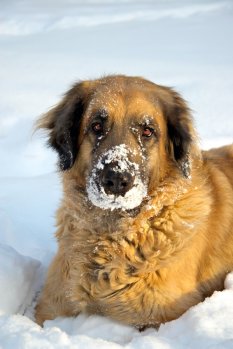
Walking in a Winter Wonderland
 Fresh air and exercise is important for both people and pets. Winter offers crisp air and a magical landscape in
which to enjoy your outings together. Before you head outdoors for a winter dog-walk,
keep a few things in mind.
Fresh air and exercise is important for both people and pets. Winter offers crisp air and a magical landscape in
which to enjoy your outings together. Before you head outdoors for a winter dog-walk,
keep a few things in mind.
Know Your Dog's Fitness Level
Dogs that usually take just a short stroll around the block may find a trek through the deep snow a little too strenuous. Likewise, short dogs may find themselves struggling to plow a path through the snow. If you plan to do some winter hiking with your dog, gradually increase your pet's exercise until he's ready to accompany you on the trails.
Protect Your Pet From The Cold
Yes, even with all their fur, pets DO get cold! Specially-made jacketsCheck Your Pet's Paws for "Snowballs"
Hard chunks of ice that form between the paw pads can be extremely painful for your pet
(think, "pebble in your shoe"). Help your dog remove these or have him wear
dog boots.
There are also paw waxes
that can help to prevent this accumulation of snow and ice in between the paw pads.
Be Aware of Snow-Melt Chemicals
Keep your dog's paws free of any chemicals used to melt snow and ice. These
chemicals can irritate the skin. Wipe your dog's paws carefully with a moist towel to
remove any chemicals, or use dog boots
or paw waxes
to protect them.
Be Alert on Recreational Trails and Areas
Be aware of other people enjoying recreational activities on the trail, such as skiiers and snowmobilers. Try to avoid trails that are primarily used for these purposes, as a collision can be very dangerous for both the person and for your pet. If your dog is off-leash make sure he comes when called and will stay put when told.
Ice Can Be Dangerous
Keep pets away from lakes or other bodies of water that may have thin ice. Walk dogs with mobility problems (such as arthritic dogs) where sidewalks or paths are clear of ice. Slipping can be dangerous for pets, too! Older pets, injured pets, or pets with mobility issues may benefit from the use of a mobility harness or slingLook Out For Spilled Antifreeze
Pets are attracted to its sweet taste, however it is extremely poisonous and even ingesting a small amount can be fatal. Contact a veterinarian immediately if you believe your pet has consumed antifreeze. Bring the container with you if it's available.
Pet owners may want to consider using antifreeze that is less toxic and safer for pets and wildlife.
Bring Water
Pets still need to stay hydrated in the winter. Bring water if you plan on going for an extended walk. Snow is not a suitable substitute for water.
Keep Paws Clean
Gently wipe your dog's paws with a moist towel after a walk. The salt used to melt
ice from sidewalks and driveways can irritate or burn your pet's paws, or cause even
bigger problems if your pet licks the salt from his paws (note, many stores now carry
pet safe ice melt).




